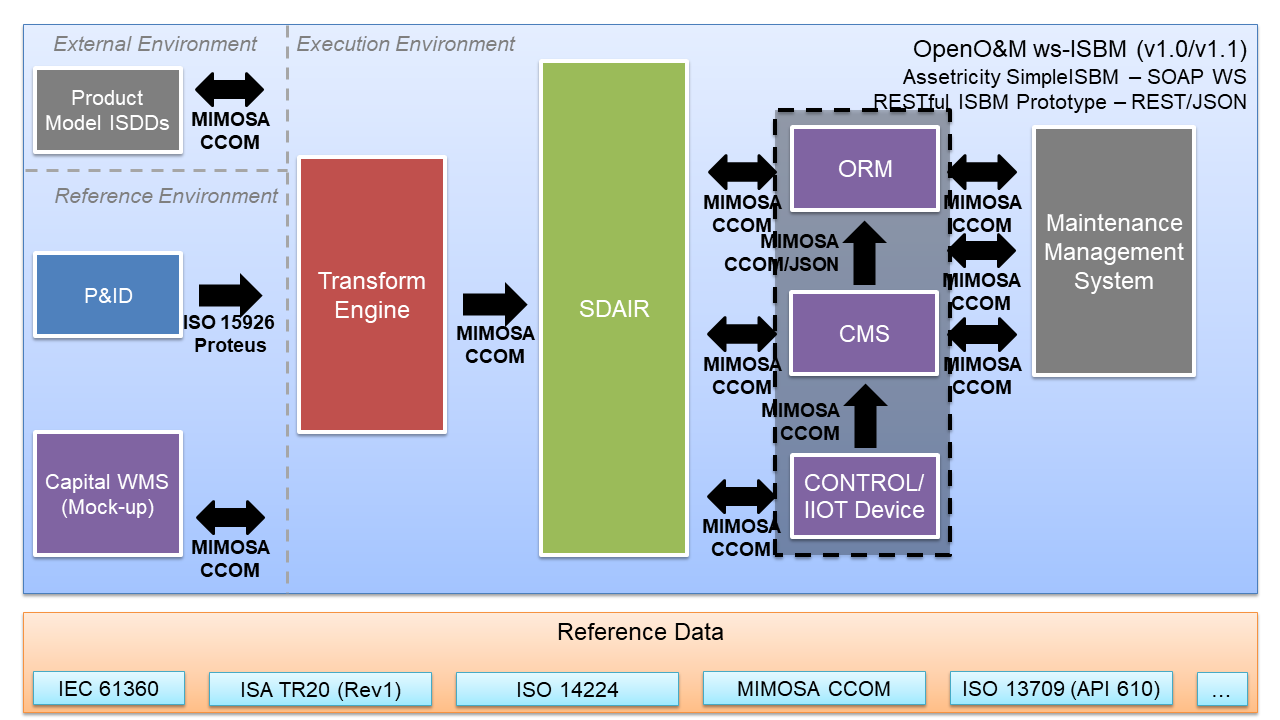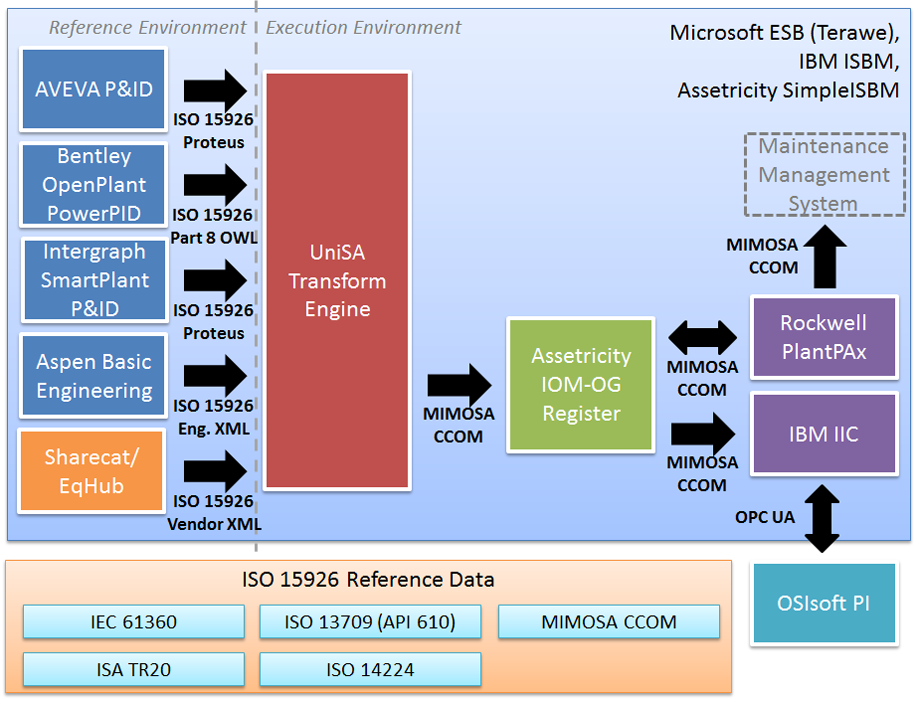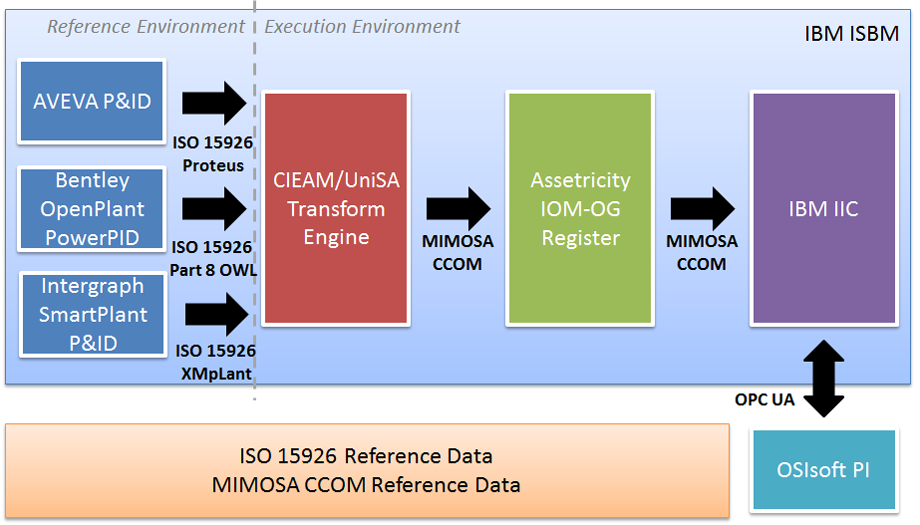The Oil and Gas Interoperability (OGI) Pilot is a public interoperability test-bed jointly run by MIMOSA in cooperation with multiple other industry associations. The Pilot uses the Open Industrial Interoperability Ecosystem (OIIE) architecture and feeds back lessons learned from implementations of OIIE Use Cases. The OGI Pilot’s purpose is to support the broader adoption of the OIIE within both the oil and gas industry (upstream and downstream) by facilitating collaboration between participants and demonstrating the current capability of software products to support the OIIE Use Cases and Scenarios. Test data sets and software tools and libraries are made freely and publicly available to support unit and integration test cases. Collaborating standards groups will be asked to help address the identified gaps on a prioritized basis in alignment with identified industry requirements. The ISO 18101 OGI Technical Specification will document the capabilities which are shown in the OGI Pilot.
MIMOSA hosts a online meeting for the OGI Pilot Team every month on Thursday afternoon ET. If you are interested in participating, please contact us for the meeting details.
The Pilot has been run in a series of phases, each focusing on a set of strategic requirements relevant to industry partners. A demonstration video of the latest phase of the OGI Pilot (Phase 3.1) is available below:
Prioritized Physical Assets
The following physical assets have been selected in order to focus the scope of work for the teams involved in the OGI Pilot. Note that these are used as reference examples and that the OIIE Architecture and Use Cases can be applied to many areas.
Downstream
Upstream
- Offshore Oil Production Platform
- Gas Gathering System
- Drilling Rig Drill String
Prioritized Use Cases
In each phase of the OGI pilot, a set of Use Cases are prioritized in conjunction with industry partners and are validated.
OGI Pilot 3.1
Phase 3.1 of OGI Pilot expanded the scope of previous Pilot phases dramatically, covering OIIE Use Cases from a range of activities across CAPEX and OPEX, including:
- OIIE Use Case 1: Information Handover from EPC to O/O
- OIIE Use Case 5: Asset Installation/Removal Updates
- OIIE Use Case 7: Condition-Based Maintenance Triggering
- OIIE Use Case 12: RFI/RFI Response for Models Meeting Requirements (Greenfield & Brownfield)
- OIIE Use Case 14: Condition-Based Maintenance Data Acquisition
- OIIE Use Case 15: Capital Project Asset Installation
These Use Cases capture some of the essential processes for building and maintaining a Digital Twin that is synchronized with changes occurring in the real-world (Sustained Lifecycle Digital Asset Management) and supporting analytics (e.g., such as that required for CBM). These essential elements include ensuring continuity of Engineering Data, the association of accurate Product Model Data to the designed and constructed Plant, event-driven updates to the model state of the Plant during both Capital Project and Operations, and the capture and analysis of Condition information leading to maintenance activities. Some of these Use Cases, e.g., OIIE Use Case 15 (Capital Project Asset Installation), are proto-Use Cases, or placeholders, which will be further developed with Industry and other Associations to reflect best practices.
Message Exchanges
Each of the OIIE Use Cases incorporates several interoperability Scenarios describing the interactions between systems. These Scenarios are performed via specific Events that are realized by message exchanges (typically as CCOM BODs) via the ISBM.
The example message exchanges used in the OGI Pilot 3.1 are available below. The package includes the used reference data and instance data for context. Data files are numbered in the sequence in which they occur (for reference/instance data this indicates the order in which they should be loaded into an SDAIR for correct reference resolution).
Data Set last updated 25 Jan. 2021
- Message Mapping (PPTX)
- Message Exchanges (ZIP)
Roadmap
At the highest level, the activities of the OGI Pilot can be categorized into two subject areas:
- Continuous Handover of Structured Digital Assets
- Sustained Lifecycle Digital Asset Management
Continuous Handover of Structured Digital Assets
This subject deals with the continuous and iterative handover of information during a capital project to an owner/operator with the intent of building the digital asset alongside the physical asset. The digital asset is not an afterthought; and emphasis is placed on ensuring the delivery of structured information that is used to establish an environment for lifecycle systems of system interoperability.
The following diagram shows the relationship of elements referenced in this subject across the typical phases in a capital project lifecycle: the relevant business actors, the structured and unstructured data content included in the interoperability scenarios, as well as references to the OIIE Use Cases that are used to document the detailed interoperability scenarios and interactions.
Sustained Lifecycle Digital Asset Management
This subject deals with the management of information within the operations and maintenance phase of an asset. Predicated on successful delivery and handover of a digital asset during a capital project, both the physical asset and digital asset are synchronously monitored and managed through distributed but coordinated processes.
The following diagram shows the relationship of elements referenced in this subject during the operations and maintenance phase: the relevant business and system actors, the structured data content included in the interoperability scenarios, as well as references to the OIIE Use Cases that are used to document the detailed interoperability scenarios and interactions.
Prioritized Classes of Information
To accelerate the utility of this work for owner/operator projects, the OGI Pilot focuses on the near term definition of graphical representation of PFDs and P&IDs, and the definition of process and instrumentation design parameters. The definition work for OEM product datasheets, as-built serialized asset parameters, and electrical diagrams (treated identically the same way as PFDs and P&IDs) become mid-term goals to be addressed as soon as the graphical representation and engineering design class work is completed. Long term goals will address other owner/operator identified requirements for capital projects and all other key types of industry supplied information that must be incorporated into life-cycle information management environments.
Application Architecture
The images below represent the application architecture and data flows throughout the different phases of the OGI Pilot.
Phase 3 (current)

Phase 2

Phase 1

Phase 1 was publicly demonstrated at the 2012 ISA Automation Week, and a live recording of the interoperability demo can be viewed here.
Participants
The following organizations have actively participated in the OGI Pilot:
- Advisian Digital
- AMEC
- AVEVA
- Assetricity
- Bentley
- BP
- Chevron
- Dow
- CII/Fiatech
- IBM
- Intergraph
- ISA
- Microsoft
- MIMOSA
- Noumenon Consulting
- OSIsoft
- PdMA Corporation
- POSC Caesar Association
- Rockwell Automation
- Southern Company
- University of South Australia
- WorleyParsons
- Yokogawa





